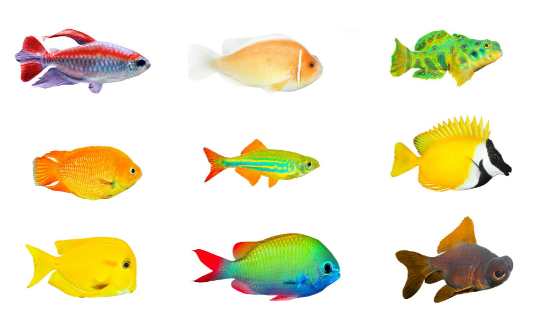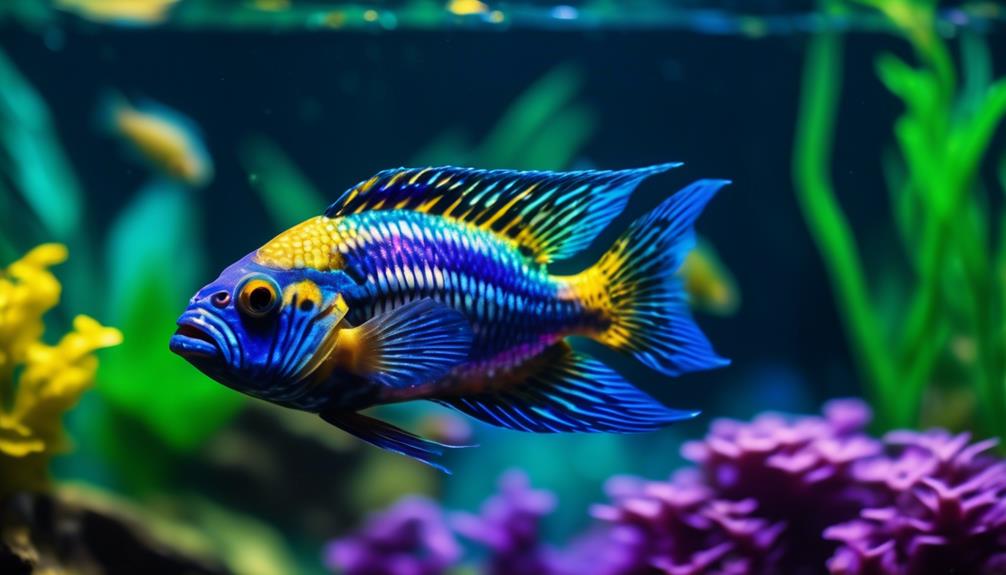
Have you ever wondered if it’s possible to bring the vibrant colors of a tropical reef into your own home?
Well, prepare to be amazed as we introduce you to the stunning and colorful Hap cichlids. These captivating creatures have long been admired for their dazzling hues and unique patterns.
But are they really as vibrant as they seem, or is it just a trick of the light? In this guide, we will uncover the truth behind their stunning colors and delve into the secrets of their mesmerizing beauty.
Get ready to embark on a journey that will leave you in awe of these magnificent creatures and eager to learn more.
Key Takeaways
- Hap cichlids are endemic to Lake Malawi and are known for their vibrant colors and unique patterns.
- They require a medium to large-sized aquarium with proper filtration and decoration.
- Compatible tank mates should be chosen carefully to avoid territorial behavior.
- Regular maintenance, including water parameter monitoring and a balanced diet, is essential for their health and color enhancement additives can be considered.
Habitat and Environment
Lake Malawi, a rift lake in Africa, serves as the natural habitat for a variety of cichlids, including the Hap cichlids. These stunning and colorful fish are commonly known as Hap cichlids and are endemic species in Lake Malawi.
The lake is home to various genus of cichlids, making it a diverse and thriving ecosystem. The Haplochromis genus, one of the largest in Lake Malawi, is where the Hap cichlids belong. With their unique body shapes, sizes, and diverse patterns and markings, these fish stand out in any aquarium. They’ve prominent fins and their coloration varies based on gender and maturity.
Lake Malawi provides the perfect environment for these beautiful fish, ensuring their optimal health and vibrant colors.
Physical Characteristics
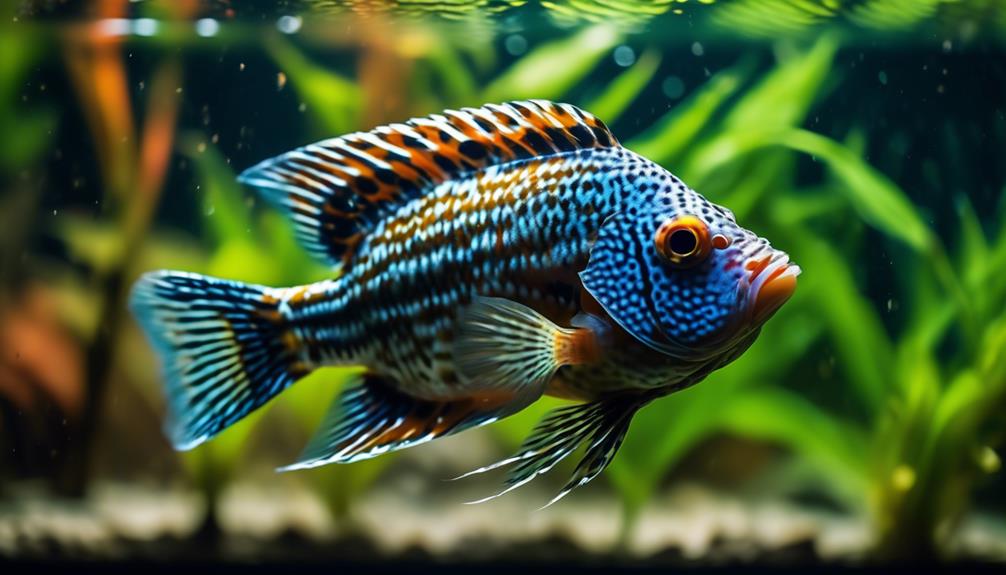
With their vibrant colors, unique body shapes, and diverse patterns and markings, Hap cichlids are visually striking fish that will captivate any aquarium enthusiast.
These stunning fish come in a wide range of colors, including vibrant blues, yellows, oranges, and reds. Their bodies are often elongated and streamlined, with some species having a more rounded shape. Hap cichlids also have prominent fins, including a dorsal fin that can be quite large and eye-catching.
The coloration of Hap cichlids can vary based on gender and maturity, with males often displaying more intense colors to attract females.
Whether you’re a seasoned aquarium hobbyist or a beginner, the physical characteristics of Hap cichlids make them a captivating addition to any tank.
Haplochromis Genus
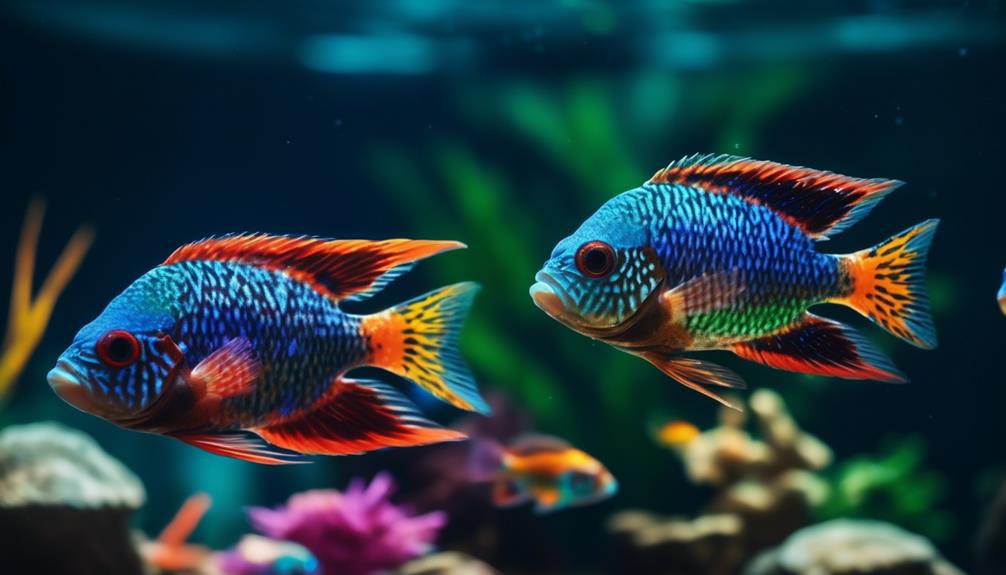
The Haplochromis genus, one of the largest found in Lake Malawi, encompasses a diverse group of cichlids with unique characteristics. These stunning fish are sure to captivate you with their vibrant colors and diverse patterns.
Here are two reasons why the Haplochromis genus is truly mesmerizing:
- Incredible Variety:
- Hap cichlids display a wide range of colors, from electric blues and vibrant yellows to fiery oranges and deep reds.
- They also showcase intricate patterns and markings, making each individual fish a work of art.
- Unique Body Shapes:
- The Haplochromis genus includes cichlids with varied body shapes and sizes, from sleek and torpedo-like to stocky and robust.
- Their prominent fins add to their visual appeal, with long flowing fins or striking dorsal fin extensions.
These fascinating characteristics make the Haplochromis genus a standout among cichlids, ensuring a visually stunning and captivating aquarium display.
Aquarium Size and Setup
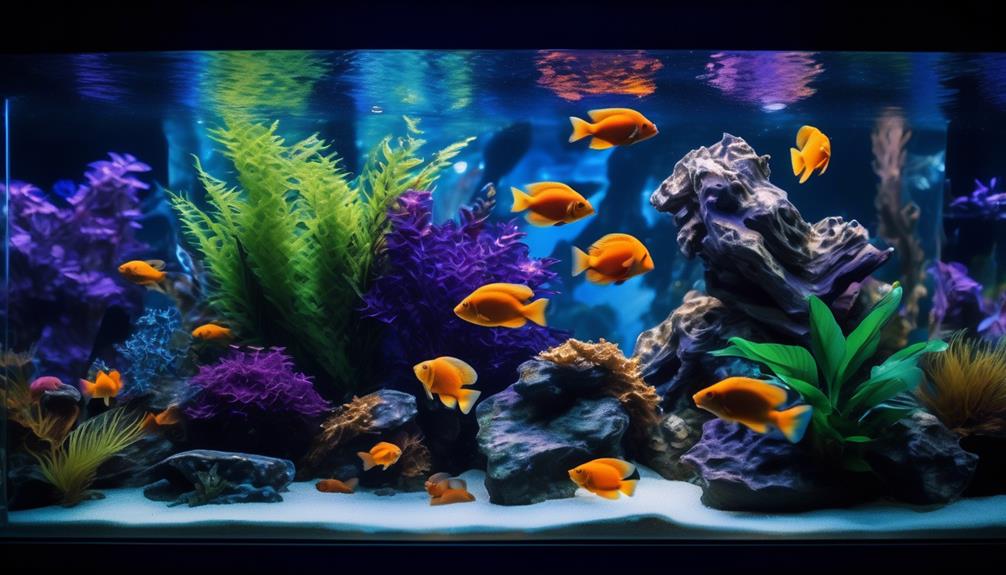
To properly accommodate Hap cichlids, it’s recommended to have a medium to large-sized aquarium. These fish require ample space to swim and establish territories. A minimum tank size of 55 gallons is suitable for a small group of Hap cichlids, but larger tanks are preferred for larger groups or multiple species.
The aquarium should be equipped with a sturdy filtration system and a heater to maintain a consistent temperature between 75 and 82 degrees Fahrenheit. Decorate the tank with rocks, caves, and sandy substrate to mimic their natural habitat and provide hiding spots. It’s also important to create open swimming areas for these active fish.
Regular water changes and maintenance are necessary to keep the water quality in optimal condition for the health and well-being of your Hap cichlids.
Suitable Tank Mates
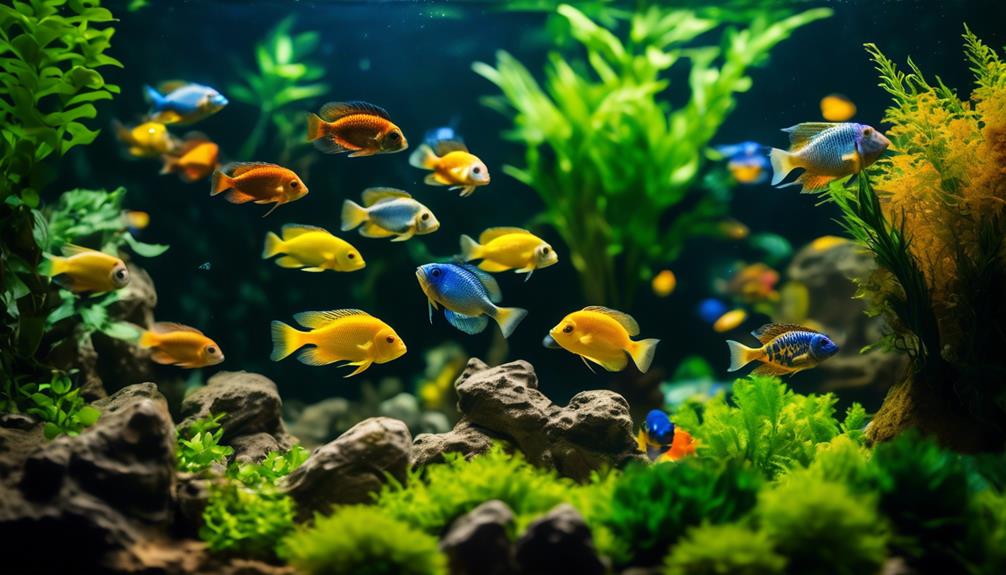
When selecting tank mates for Hap cichlids, consider their semi-aggressive temperament and size to ensure compatibility in the aquarium. It’s important to choose tank mates that can hold their own against the Haps, as they may exhibit territorial behavior. Here are some suitable tank mates to consider:
- Large non-aggressive cichlids: These peaceful companions can coexist with Hap cichlids without any issues. They provide a contrasting size and temperament, creating a harmonious tank environment.
- Lake Victoria cichlids: These colorful cichlids from Lake Victoria can add a vibrant touch to your aquarium. They’re known for their peaceful nature, making them suitable companions for Hap cichlids.
Feeding Habits and Diet
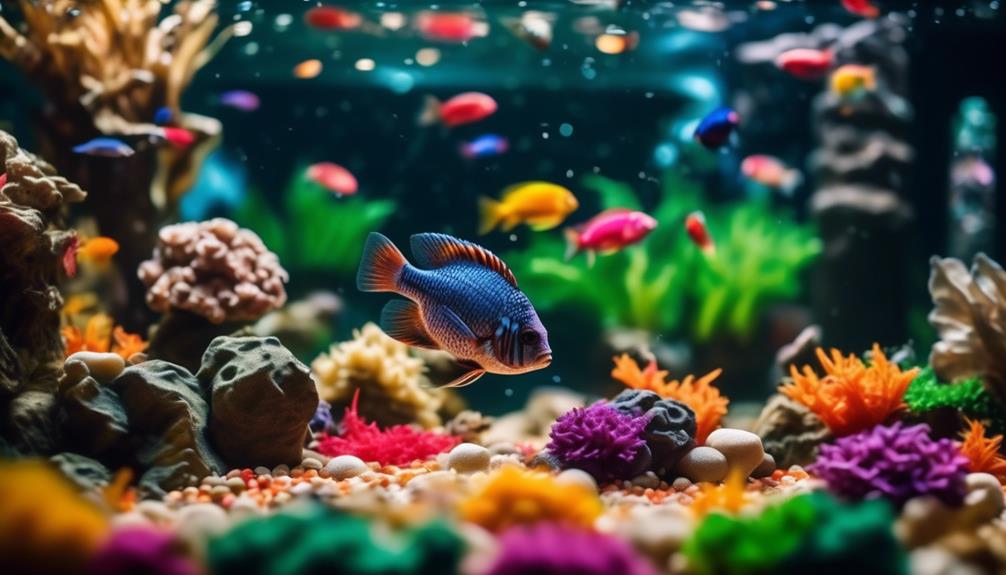
To ensure the optimal health and vibrant colors of your Hap cichlids, it’s important to understand their feeding habits and diet.
Hap cichlids have an omnivorous diet, meaning they eat both plant and animal matter. In their natural habitat of Lake Malawi, their diet consists of small invertebrates and algae.
To replicate their natural diet in captivity, you can feed them high-quality pellets and flakes that are specifically formulated for cichlids. It’s also recommended to supplement their diet with live or frozen foods, such as brine shrimp or bloodworms, to provide them with additional nutrients.
A balanced diet is crucial for their overall health and to enhance their vibrant colors. Remember to feed them in small portions multiple times a day to prevent overeating and maintain water quality.
Water Conditions and Care
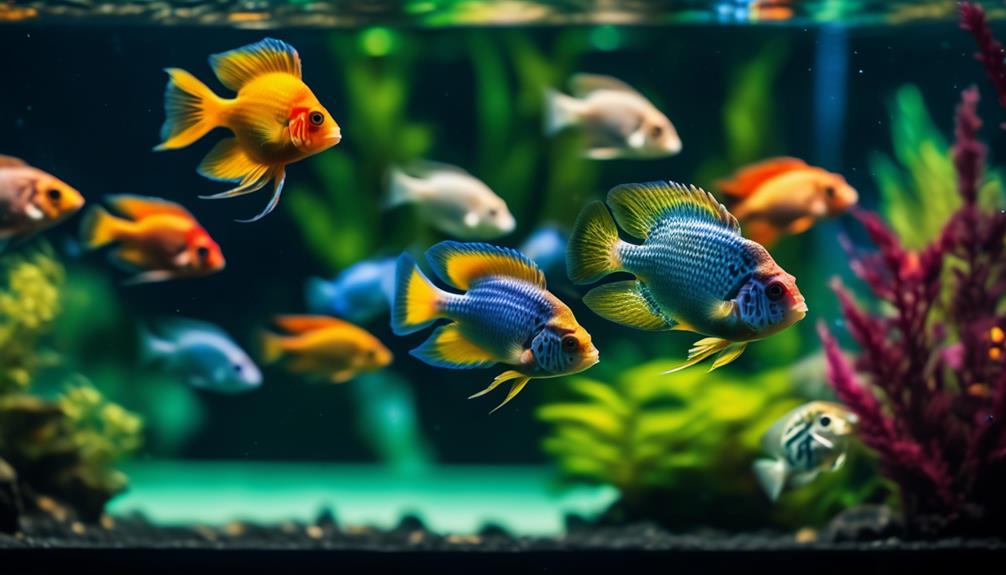
Maintaining the proper water conditions and care is essential for the health and well-being of your Hap cichlids. To ensure their thriving environment, here are some important factors to consider:
- Water temperature: Keep the water warm between 75-82°F, as Hap cichlids are native to the warm waters of Lake Malawi. This will help them stay active and vibrant.
- Water hardness and alkalinity: Hap cichlids prefer hard and alkaline water with a pH of 7.8-8.5. This mimics their natural habitat and promotes their overall well-being.
Breeding and Reproduction
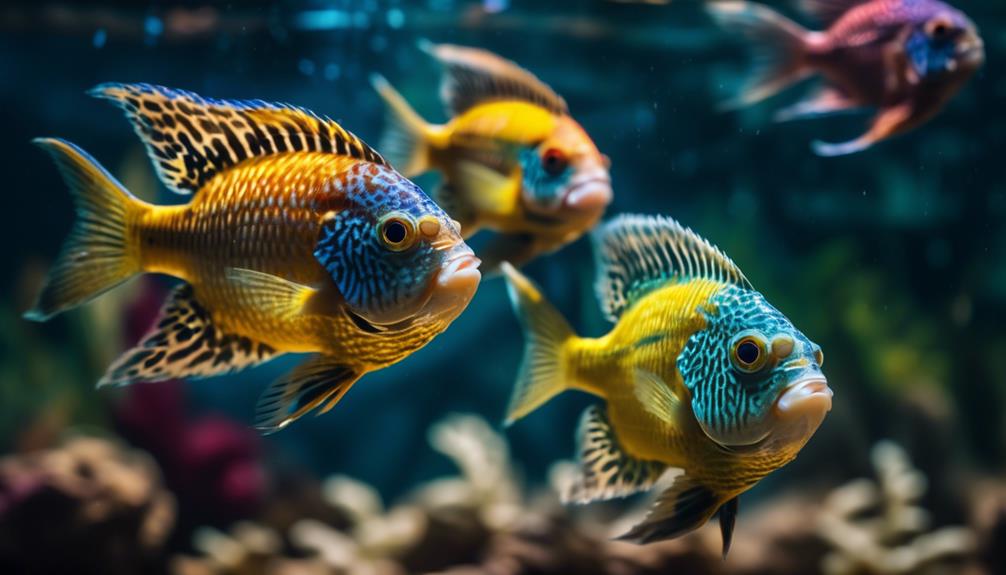
Breeding and reproduction are essential aspects of raising Hap cichlids, ensuring the continuation of their vibrant and diverse species.
When it comes to breeding Hap cichlids, it’s important to create a suitable environment that mimics their natural habitat. Provide them with appropriate hiding spots, such as caves or rock formations, where they can lay their eggs and protect their young.
The water temperature should be kept around 78-82°F, and the pH level should be slightly alkaline. To encourage spawning, it’s recommended to have a ratio of one male to multiple females.
Once the eggs are laid, the male will fertilize them, and both parents will take turns guarding the nest. After about three days, the fry will hatch, and you can start feeding them with newly hatched brine shrimp or crushed flakes.
With proper care and attention, you can witness the joy of breeding Hap cichlids and watching their offspring thrive.
Common Health Issues
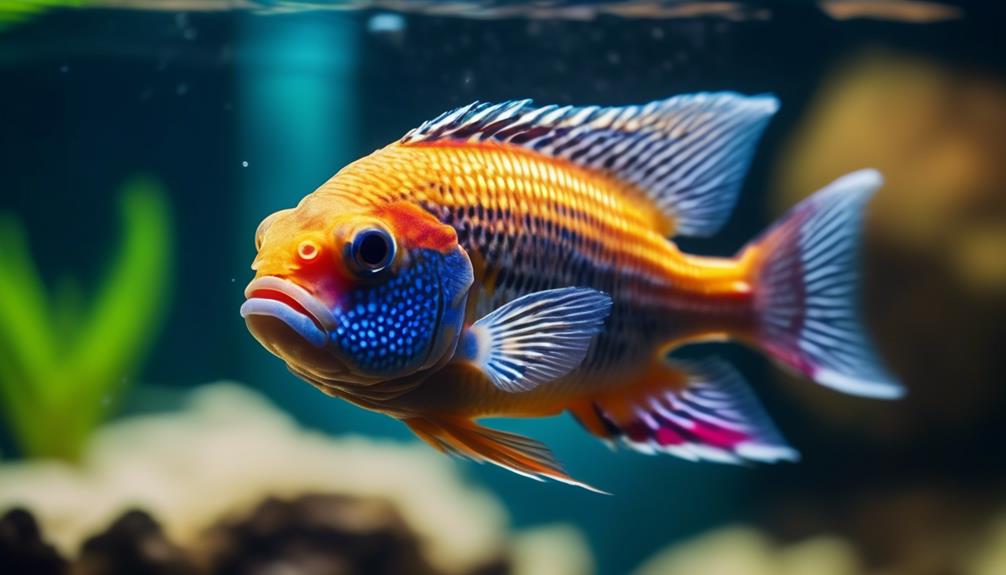
After successfully breeding Hap cichlids, it’s important to be aware of the common health issues that may affect these vibrant and diverse species. Taking care of their health is crucial to maintaining their stunning appearance and ensuring their longevity. Here are common health issues to watch out for:
- Disease susceptibility: Hap cichlids can be susceptible to various diseases such as ich, fin rot, and bloat. Seeing your beloved fish suffer from these ailments can be distressing, so it’s essential to monitor their behavior and appearance regularly.
- Water quality problems: Poor water quality can lead to stress, weakened immune systems, and ultimately, illness. It can be heartbreaking to witness your Hap cichlids struggling due to inadequate water conditions, so maintaining proper filtration, regular water changes, and monitoring water parameters is crucial.
Taking proactive measures to address these health issues will help ensure the continued vibrancy and beauty of your Hap cichlids, allowing them to thrive in their aquatic home.
Tips for Enhancing Colors
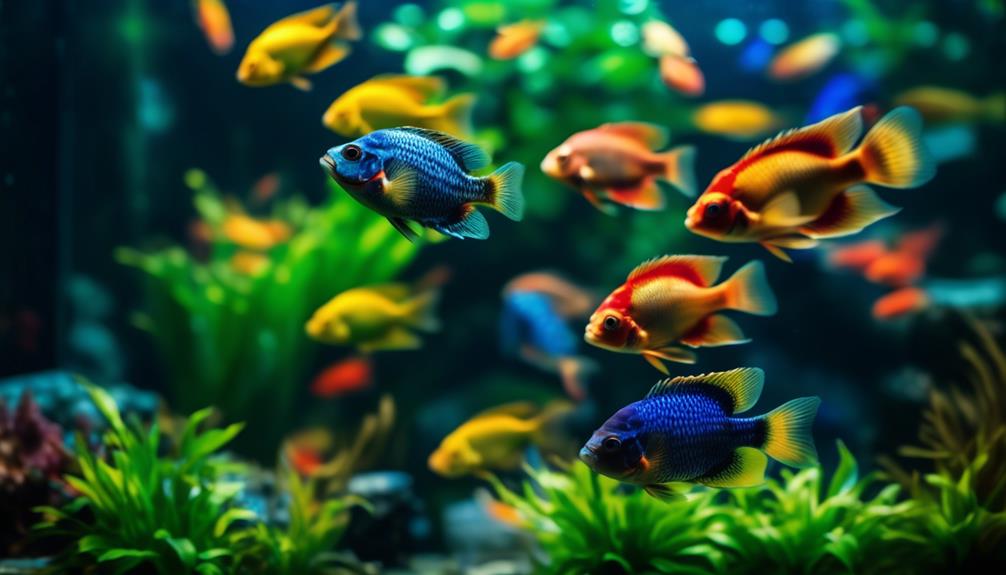
To enhance the vibrant colors of your Hap cichlids, there are several tips you can follow.
First, provide a balanced and nutritious diet. Include high-quality pellets and flakes as their main food source, but also supplement their diet with live or frozen foods like brine shrimp or bloodworms. This will ensure they receive all the necessary nutrients for optimal health and coloration.
Additionally, maintain good water quality by regularly testing and monitoring the water parameters. Hap cichlids thrive in warm, hard, and alkaline water conditions, so make sure to keep the pH and temperature levels stable.
Lastly, consider adding color-enhancing additives to their diet or the aquarium water. These additives contain natural pigments that can help intensify and enhance the colors of your Hap cichlids. Remember to follow the dosage instructions carefully to avoid any negative effects on your fish.
Conclusion and Resources
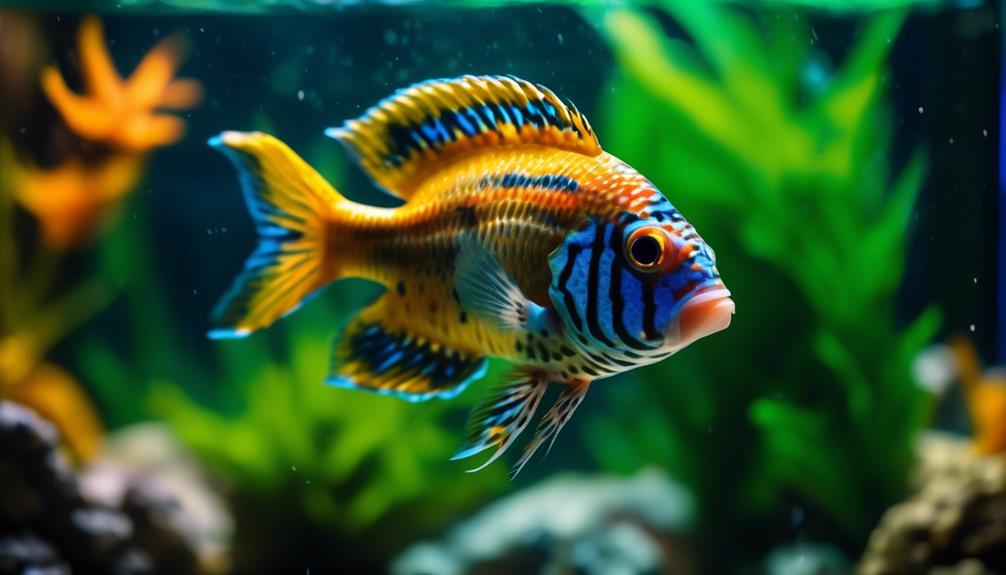
In conclusion, Hap cichlids are a fascinating species of fish that can bring vibrant colors and unique patterns to your aquarium. By adding these stunning fish to your tank, you can create a visually striking and captivating underwater world. Not only will they enhance the aesthetic appeal of your aquarium, but they’ll also provide you with endless hours of entertainment as you observe their behaviors and interactions.
Additionally, keeping Hap cichlids can be a rewarding and educational experience, allowing you to learn more about their natural habitat and behavior. With proper care and attention, these colorful fish can thrive and become the centerpiece of your aquatic display.
If you’re looking to add a touch of vibrancy to your aquarium, Hap cichlids are an excellent choice.
Resources:
- [The Complete Guide to Hap Cichlids](https://www.aquariumsource.com/hap-cichlids/)
- [Lake Malawi Cichlids](https://www.cichlid-forum.com/articles/lakemalawi.php)
Frequently Asked Questions
How Many Species Are There in the Haplochromis Genus?
There are numerous species in the Haplochromis genus. They are part of one of the largest genera found in Lake Malawi, a rift lake in Africa.
What Are Some Common Health Issues That Hap Cichlids May Face?
Hap cichlids may face common health issues like fin rot, ich, and swim bladder disorders. Regular water changes, proper diet, and monitoring water parameters can help prevent these issues and keep your fish healthy.
Are There Any Tips for Enhancing the Vibrant Colors of Hap Cichlids?
To enhance the vibrant colors of your hap cichlids, make sure to provide a balanced diet with high-quality pellets and flakes. Supplement their diet with live or frozen foods for optimal health and vibrant colors.
What Are Some Suitable Tank Mates for Hap Cichlids?
Some suitable tank mates for hap cichlids include large non-aggressive cichlids, Lake Victoria cichlids, and non-conspecific cichlids. It’s important to choose tank mates that won’t cause conflicts in the aquarium.
How Can Hap Cichlids Be Bred and What Is Their Reproduction Process Like?
To breed Hap cichlids, create a separate breeding tank with appropriate water conditions. Provide caves or flat surfaces for spawning. The male will entice the female to lay eggs, which he will then fertilize and guard until hatching.
What Are the Similarities and Differences Between Hap Cichlids and Ram Cichlids?
Hap cichlids and ram cichlids both have a wide range of color varieties and require specific care. However, hap cichlids are larger and more aggressive, while ram cichlids are smaller and more peaceful. They both thrive in slightly acidic water and need ample space in their tanks.
Conclusion
In conclusion, Hap cichlids are an excellent addition to any aquarium enthusiast’s collection. With their stunning colors, unique body shapes, and vibrant patterns, they’re sure to be the centerpiece of your tank.
These fish thrive in a well-maintained habitat and can coexist with suitable tank mates. By providing proper care and nutrition, you can enhance their colors and ensure their overall health and well-being.
So don’t hesitate to add these mesmerizing creatures to your aquarium and enjoy their beauty for years to come.




